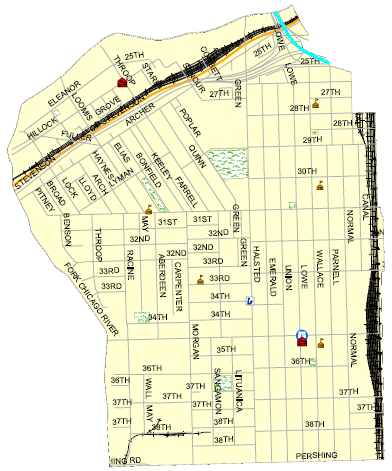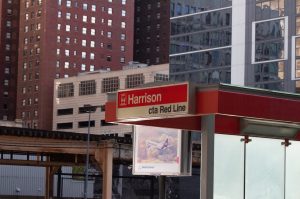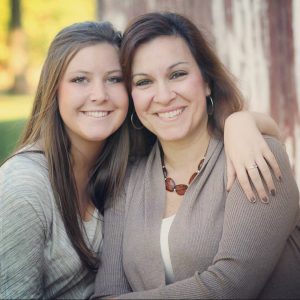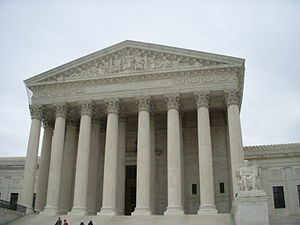
Ronny Waterhouse, a 29-year-old Mexican-American, said he felt his Bridgeport neighborhood was pretty safe and he didn’t worry about crime, but his life in the South Side wasn’t always peaceful.
He said there was a shooting at a gas station across the street from an apartment where he used to live. He was at home when the police drove up to the gas station, and the robber and police exchanged gunfire.
He said he watched safely from his window, but the incident has not prompted him to move out of the neighborhood.
“Crime happens anywhere,” he said.
He said he prefers not to go out to bars or stay out late at night because he isn’t into that type of lifestyle. He prefers to remain at home in the evenings after working at a local Mexican restaurant. Waterhouse said there are good parts of the neighborhood, including one of his favorite restaurants: Pancho Bristola.
Waterhouse was one of a handful of Bridgeport residents who commented on their neighborhood. Many reported witnessing serious crime there. According to Area Vibes Website, the Bridgeport crime rate is 2 percent higher than the Chicago average, but Bridgeport is safer than 57 percent of the neighborhoods in Chicago.
The Chicago Tribune crime website shows that property and quality-of-life crimes, such as drug sales and prostitution, have been dropping over the past 10 years. But, several residents had a different perception, saying they had seen an increase in crime in the area.
Some said they have been victims of serious crime there.
“A man pulled a gun on me around midnight and asked me for whatever I had on me,” said Stacy Huang, who has lived in Bridgeport for five years. “I told him that I had nothing for him and he turned and ran away.”
She said he seemed like an inexperienced robber because he wasn’t very effective and didn’t harm or shoot her. She said she was surprised that she wasn’t shot dead.
Huang said that after that, she thought it best to be indoors by 10:30 p.m. every night.
She said she makes sure she takes her garbage to the alley earlier each day to avoid any of the troublemakers who walk the alleys late at night.
Huang said she chose to live in Bridgeport because it is close to Chinatown and also close to her workplace. Many of the Chinese-Americans who can’t get housing in Chinatown move to Bridgeport because it is close by and already populated by many Chinese residents, she added.
Bridgeport was founded by Lithuanians during the 1800s, according to the Encyclopedia of Chicago website, and many Lithuanians in the neighborhood.
According to Area Vibes, the near South Side neighborhood has 33,700 residents; 57 percent are white, 25 percent are Asian, 1 percent African-American and 18 percent other.
Bridgeport is a blue-collar community with a median household income of about $35,000. The influx of Asians is creating another change in the culture as now about 25 percent of the population speaks Chinese, according to Area Vibes.
Huang said she uses the CTA to get around everyday, and it is convenient to get anywhere from Bridgeport. It is also easy for her child to get to school each day from her apartment, she added.
Yet recently the nearby Walgreen’s drugstore hired an armed security guard when they previously didn’t, and that has her worried that crime has gone up, she said.
Cindy Zak, a middle-aged resident who said she was a former writer for ParentLife Magazine, said she felt Bridgeport is pretty safe.
“I usually have to walk at night because I work until 11 p.m. each day and have to take public transportation home,” Zak said.
She said she felt safe until about 2 a.m., but south of Bridgeport near Englewood is not as safe. Zak described the crime as mild compared to that in Englewood.
Lina Eimontas, a Lithuanian immigrant, has lived in Bridgeport for 12 years. She said she enjoys Bridgeport, but she feels that there are more gangs in the neighborhood than before.
She said she is not afraid of the crime because she feels comfortable and at home there.
Eimontas said she is one of the eastern Europeans who remain in this old community even as the population shifts to more Chinese and Hispanics.
Louie Reynoso, 28, has lived in Bridgeport for about a year. He said he prefers to ride his bike around for his job. He works in a bike shop just to the north of Bridgeport on Wells Street, he said.
He said Bridgeport has some “sketchy spots” to it, so people should be aware of where they are.
“Some of Bridgeport isn’t safe at night, ” said Reynoso. But, he added, “This neighborhood is alright.” He loves visiting the art shops on Morgan Street, he said.
Hispanic resident Maria Vazquez has lived in Bridgeport for 30 years. She said although her English isn’t perfect, it is good enough to get along with the local merchants.
According to Vazquez, with many Hispanics living in Bridgeport, she has plenty of friends to converse with in her own language.
She said Bridgeport is “beautiful during the day,” yet she never goes out after dark.
“I don’t like to see groups of people hanging out on street corners because I’m not certain what they are up to,” Vazquez said.
She said she believes that Bridgeport has become more crime-ridden in the last few years as residents are changing in their ethnic background.








Be First to Comment